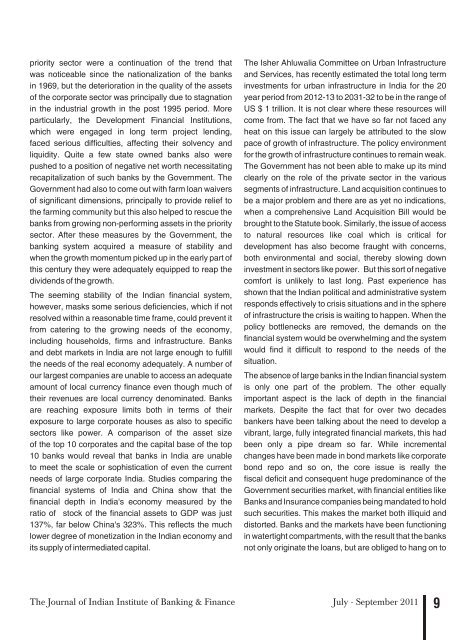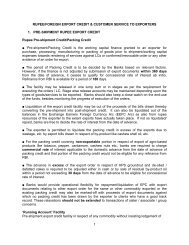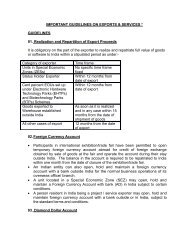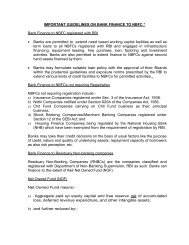Keb[ / DebkeÀ / pegueeF& - efmelebyej /
special feature - Indian Institute of Banking & Finance
special feature - Indian Institute of Banking & Finance
- No tags were found...
You also want an ePaper? Increase the reach of your titles
YUMPU automatically turns print PDFs into web optimized ePapers that Google loves.
priority sector were a continuation of the trend thatwas noticeable since the nationalization of the banksin 1969, but the deterioration in the quality of the assetsof the corporate sector was principally due to stagnationin the industrial growth in the post 1995 period. Moreparticularly, the Development Financial Institutions,which were engaged in long term project lending,faced serious difficulties, affecting their solvency andliquidity. Quite a few state owned banks also werepushed to a position of negative net worth necessitatingrecapitalization of such banks by the Government. TheGovernment had also to come out with farm loan waiversof significant dimensions, principally to provide relief tothe farming community but this also helped to rescue thebanks from growing non-performing assets in the prioritysector. After these measures by the Government, thebanking system acquired a measure of stability andwhen the growth momentum picked up in the early part ofthis century they were adequately equipped to reap thedividends of the growth.The seeming stability of the Indian financial system,however, masks some serious deficiencies, which if notresolved within a reasonable time frame, could prevent itfrom catering to the growing needs of the economy,including households, firms and infrastructure. Banksand debt markets in India are not large enough to fulfillthe needs of the real economy adequately. A number ofour largest companies are unable to access an adequateamount of local currency finance even though much oftheir revenues are local currency denominated. Banksare reaching exposure limits both in terms of theirexposure to large corporate houses as also to specificsectors like power. A comparison of the asset sizeof the top 10 corporates and the capital base of the top10 banks would reveal that banks in India are unableto meet the scale or sophistication of even the currentneeds of large corporate India. Studies comparing thefinancial systems of India and China show that thefinancial depth in India's economy measured by theratio of stock of the financial assets to GDP was just137%, far below China's 323%. This reflects the muchlower degree of monetization in the Indian economy andits supply of intermediated capital.special featureThe Isher Ahluwalia Committee on Urban Infrastructureand Services, has recently estimated the total long terminvestments for urban infrastructure in India for the 20year period from 2012-13 to 2031-32 to be in the range ofUS $ 1 trillion. It is not clear where these resources willcome from. The fact that we have so far not faced anyheat on this issue can largely be attributed to the slowpace of growth of infrastructure. The policy environmentfor the growth of infrastructure continues to remain weak.The Government has not been able to make up its mindclearly on the role of the private sector in the varioussegments of infrastructure. Land acquisition continues tobe a major problem and there are as yet no indications,when a comprehensive Land Acquisition Bill would bebrought to the Statute book. Similarly, the issue of accessto natural resources like coal which is critical fordevelopment has also become fraught with concerns,both environmental and social, thereby slowing downinvestment in sectors like power. But this sort of negativecomfort is unlikely to last long. Past experience hasshown that the Indian political and administrative systemresponds effectively to crisis situations and in the sphereof infrastructure the crisis is waiting to happen. When thepolicy bottlenecks are removed, the demands on thefinancial system would be overwhelming and the systemwould find it difficult to respond to the needs of thesituation.The absence of large banks in the Indian financial systemis only one part of the problem. The other equallyimportant aspect is the lack of depth in the financialmarkets. Despite the fact that for over two decadesbankers have been talking about the need to develop avibrant, large, fully integrated financial markets, this hadbeen only a pipe dream so far. While incrementalchanges have been made in bond markets like corporatebond repo and so on, the core issue is really thefiscal deficit and consequent huge predominance of theGovernment securities market, with financial entities likeBanks and Insurance companies being mandated to holdsuch securities. This makes the market both illiquid anddistorted. Banks and the markets have been functioningin watertight compartments, with the result that the banksnot only originate the loans, but are obliged to hang on toThe Journal of Indian Institute of Banking & Finance July - September 2011 9

















